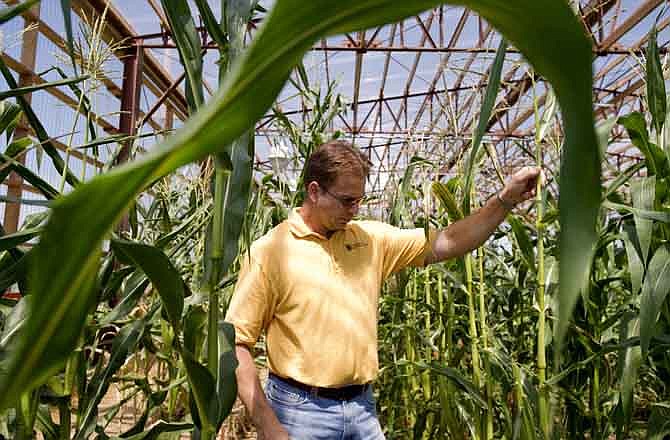COLUMBIA, Mo. (AP) - Felix Fritschi likes to damage plants.
He's no vandal. The plant scientist and his colleagues at the University of Missouri are using a new device to deprive plants of water in an effort to better understand how they're affected by drought. The researchers hope their work will help develop drought-resistant crops for use by farmers.
The drought simulator - think motorized greenhouse on rails - allows Missouri researchers to mimic short dry spells as well as persistent or even severe droughts. A handful of similar machines can be found elsewhere in the U.S. and overseas, particularly in China and India. They give scientists an edge by letting them control precisely how much water plants receive.
"Normally in the field, we're dependent on natural conditions," Fritschi said. "The problem with that is, the sensitivity of plants to drought stress is different depending upon their developmental stages. "If we want to control that time aspect, we need something (to deliver water) whenever we want."
A $1.5 million grant from the Missouri Life Sciences Research Board enabled the university to build two adjacent shelters, each 50 feet by 100 feet with a translucent roof. Rain gauges trigger an oversized garage door that covers the corn and soybean plots at the first sign of water and lowers once the rain passes.
Fritschi and co-investigators Robert Sharp, Rob Kallenbach, and Grover Shannon also plans to use the drought simulators, sometimes referred to as rainout shelters, as "heat tents" to measure the effect of rising temperatures on plant growth, since "drought and heat often occur together. Those are the two biggest stresses on plants."
A dozen researchers, including water quality scientists, soil biologists and physicists and plant breeders, will collaborate with Fritschi on the long-term project. They hope to build two more shelters in parts of the state with significantly different soil types - the sand loams of southeast Missouri, where cotton and rice sprout along the Mississippi River valley, and the Missouri River hills at the university's Horticulture and Agroforestry Research Center in New Franklin, where Chinese chestnuts are grown about one hour west of Columbia.
Drought is a recurring problem in Missouri, even in years like this one where summer floods from the upper Missouri River overran fields and shut down an interstate highway in the state's northwest corner.
The simulators were put up this summer, so research data so far is scant. But landscape researchers at a Texas A&M University lab in San Antonio have used drought simulators for several years to help the city's water district test turf grasses' ability to withstand summer dry spells.
The often-parched city passed an ordinance in 2005 requiring new residential and commercial construction to include only approved turf grasses with "summer dormancy capabilities" - but didn't specify which ones met those requirements.
"After they passed it, they realized there was very little information about 60-day drought recovery on turf grass," said Guy Fipps, director of the Texas A&M Irrigation Technology Center in College Station.
"We know how much water turf likes," Fipps said. "But the question is, how much can you cut that water back without compromising quality?"
A two-year study found that grasses with 4-inch roots failed to survive the simulated drought, but those with roots of 18 inches or more endured. The work enabled the San Antonio water district to let homeowners and developers know which varieties could endure South Texas summer droughts.
Mike Hayes, director of the National Drought Mitigation Center at the University of Nebraska-Lincoln, called the drought simulators "a fairly robust way" of advancing research on an issue critical to agriculture. The development of hybrids and other agricultural research has already helped U.S. farms cut their water use, but drought remains a problem.
"Over the years, there have been many efforts to try to simulate drought," said Hayes, who earned his master's and doctorate degrees at Missouri. "The way they've described it, and their plans for it, go a step beyond."

